ILVE IVFSD61 User Manual

Dishwasher Operating
& Installation Manual
ILVE Dishwasher Installation and Operating Instructions template pages.indd 1 |
|
|
1/05/2015 9:16 am |
|
|
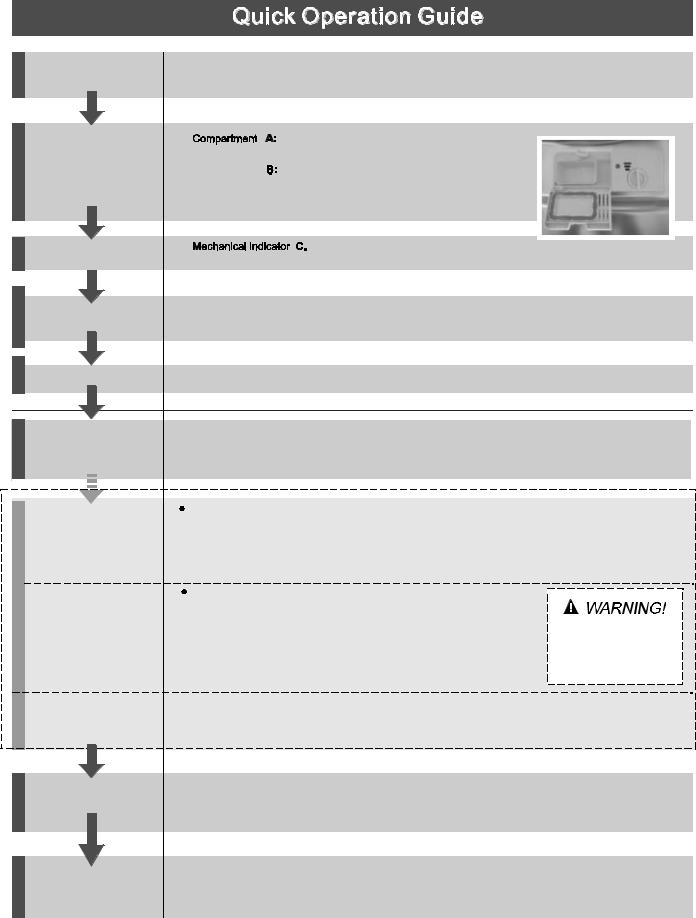
For detailed operating method read the corresponding content on the instruction manual.
Switch on the appliance
Fill the detergent dispenser
Check the rinse aid level
Load the baskets
Select a programme
Running the dishwasher
 Changing the programme
Changing the programme
 Add forgotten dishes in the dishwasher.
Add forgotten dishes in the dishwasher.
 If the appliance is switched off during a wash cycle.
If the appliance is switched off during a wash cycle.
Switch off the appliance
Turn off the water tap, unload the baskets
Open the door, press the On/Off button to switch on the appliance.
For each wash cycle. |
|
C |
Compartment |
A |
B |
For programs with pre-wash only. |
|
|
(Follow the user instructions) |
|
|
Electric indicator on control panel (if provided).
Scrape off any large food particles. Soften remnants of burnt food in pans, then load the baskets. Refer to the dishwasher loading instructions.
Close the door, press the Program Button until the selected program lights up. ( See the section entitledo Operation instructionp )
Turn on the water tap and close the door. The machine will start working after about 10 seconds.
1. A running cycle can only be modified if it has been running for a short time. Otherwise the detergent may have already been released and the water already drained. If this is the case, the detergent dispenser must be refilled.
2.Open the door. Press the program button more than 3s to cancel the current program.
3.After cancel the current program, press the program button again to select a new program.
4.Close the door, then the dishwasher will start work again.
1.Open the door a little to stop the dishwasher.
2.After the spray arms stop working, you can open the door completely. 3.Add the forgotten dishes.
4.Close the door, the dishwasher will start running again after 10 seconds.
 If the appliance is switched off during a wash cycle, when switched
If the appliance is switched off during a wash cycle, when switched
on again, please re-select the washing cycle and operate the dishwasher according to the original Power-on state ).
Open the door carefully. Hot steam may escape when the door is opened!
When the working cycle is finished, the buzzer of the dishwasher will sound 8 times, then stop.
Turn off the appliance using the On/Off Button.
If the appiance was under standby mode, it will be power off automaticly after 30 minutes without any operation.
Warning: wait a few minutes (about 15 minutes) before unloading the dishwasher to avoid scald,as the dishes and utensils are still hot and more susceptible to break.
They could also dry better.Unload the appliance, starting from the lower basket.
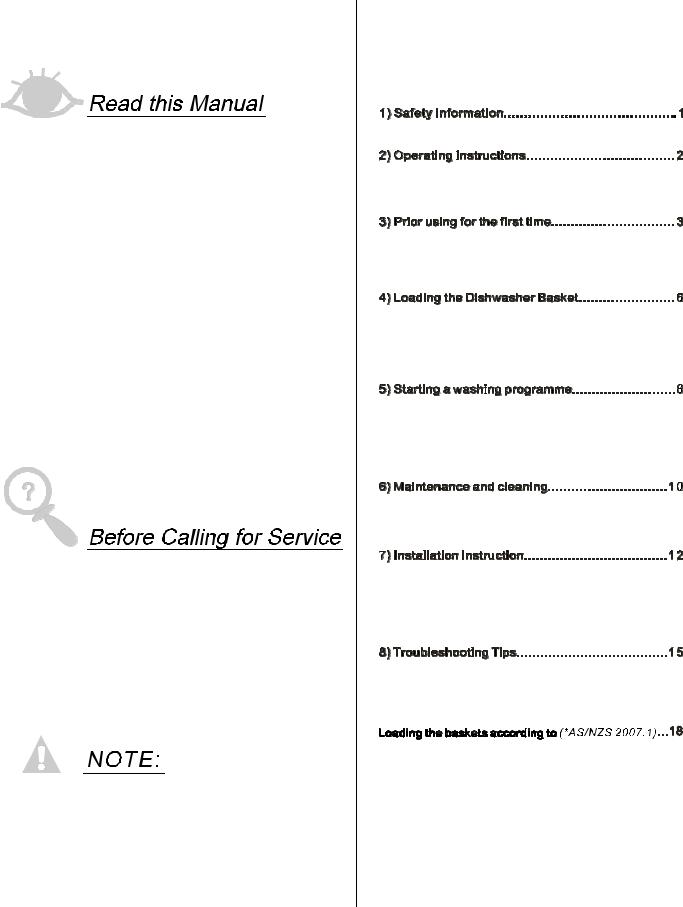
Dear Customer,
This appliance is intended to be used in household and similar applications such as:
-staff kitchen areas in shops, offices and other working environments;
-farm houses;
-by clients in hotels, motels and other residential type environments;
-bed and breakfast type environments.
 Please carefully read this manual before using the dishwasher, it will help you to use and maintain the dishwasher properly.
Please carefully read this manual before using the dishwasher, it will help you to use and maintain the dishwasher properly.
 Keep it for reference in future .
Keep it for reference in future .
 Pass it on to any subsequent owner of the appliance.
Pass it on to any subsequent owner of the appliance.
This manual contains sections on safety Instructions, Operating Instructions, Installation Instructions and Troubleshooting Tips etc.
 To review the section on troubleshooting Tips will help you to solve some common problems by yourself .
To review the section on troubleshooting Tips will help you to solve some common problems by yourself .
 If you can not solve the problems by yourself ,
If you can not solve the problems by yourself ,
please ask for the help from professional technicians.
The manufacturer, following a policy of constant development and updating of the product, may make modifications without giving prior notice.
Control Panel....................................................... |
2 |
Dishwasher Features.................................... ....... |
2 |
Aq Fill the Rinse Aid Dispenser.......................... ... |
3 |
Bq Function of Detergent ..................................... |
4 |
Attention before or after loading the Dishwasher |
|
Baskets.............................................................. |
6 |
The Method Loading Normal Dishware................... |
7 |
Wash Cycle Table................................................. |
8 |
Turning on the Appliance...................................... |
8 |
Change the Programme........................................ |
9 |
At the End of the Wash Cycle................................. |
9 |
Filtering System................................................. |
10 |
Caring for the Dishwasher................................... |
11 |
Positioning the Appliance................................... |
12 |
About Power Connection.................................... |
12 |
Water Connection.............................................. |
13 |
Start of dishwasher............................................ |
14 |
Before calling for service..................................... |
15 |
Error codes....................................................... |
16 |
Technical information......................................... |
17 |
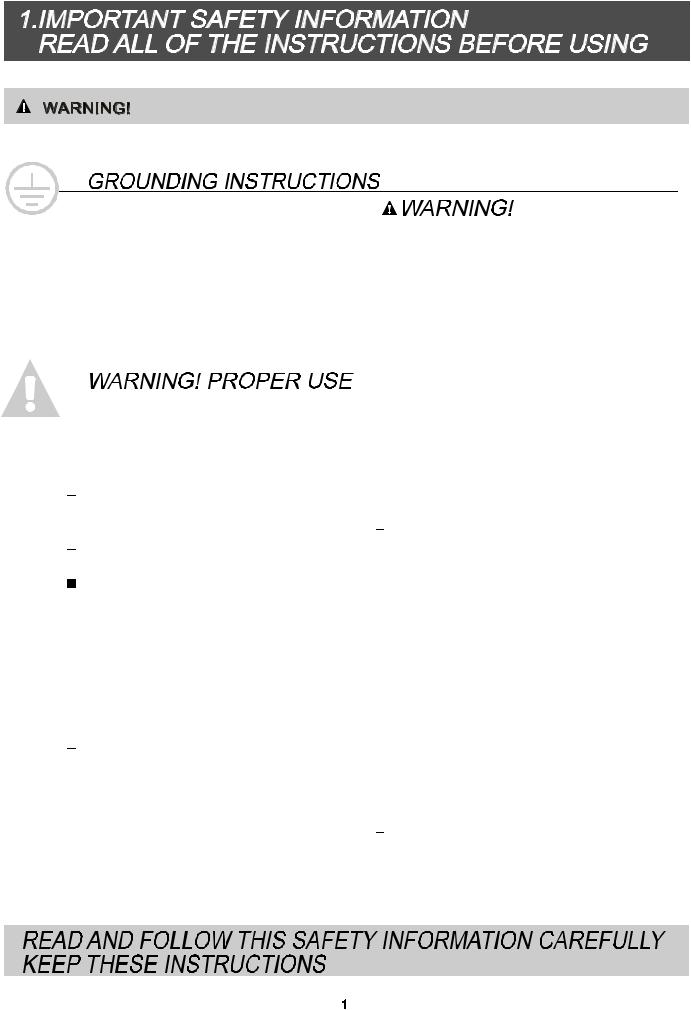
When using your dishwasher, follow the precautions listed below:

 This appliance must be grounded. In the event of a malfunction or breakdown, grounding will reduce the risk of an electric shock by providing a path of least resistance of electric current. This appliance is equipped with a cord having an equipmentgrounding conductor and a grounding plug.
This appliance must be grounded. In the event of a malfunction or breakdown, grounding will reduce the risk of an electric shock by providing a path of least resistance of electric current. This appliance is equipped with a cord having an equipmentgrounding conductor and a grounding plug.

 The plug must be plugged into an appropriate outlet that is installed and grounded in accordance with all local codes and ordinances.
The plug must be plugged into an appropriate outlet that is installed and grounded in accordance with all local codes and ordinances.
 Do not abuse, sit on, or stand on the door or dish rack of the dishwasher.
Do not abuse, sit on, or stand on the door or dish rack of the dishwasher.

 Do not touch the heating element during or immediately after use.
Do not touch the heating element during or immediately after use.
(This instruction is only applicable to machines with a visual heating element.)

 Do not operate your dishwasher unless all enclosure panels are properly in place. Open the door very carefully if the dishwasher is operating, there is a risk of water squirting out.
Do not operate your dishwasher unless all enclosure panels are properly in place. Open the door very carefully if the dishwasher is operating, there is a risk of water squirting out.

 Do not place any heavy objects on or stand on the door when it is open. The appliance could tip
Do not place any heavy objects on or stand on the door when it is open. The appliance could tip
forward.
When loading items to be washed:
1)Locate sharp items so that they are not likely to damage the door seal;
2)Warning: Knives and other utensils with sharp points must be loaded in the basket with their points down or placed in a
horizontal position.

 When using your dishwasher, you should prevent plastic items from coming into contact with the heating element.(This instruction is only applicable to machines with a visual heating element.)
When using your dishwasher, you should prevent plastic items from coming into contact with the heating element.(This instruction is only applicable to machines with a visual heating element.)

 Check that the detergent comparment is empty after completion of the wash cycle.
Check that the detergent comparment is empty after completion of the wash cycle.

 Do not wash plastic items unless they are marked dishwasher safe or the equivalent. For plastic items not so marked, check the manufacturer's recommendations.
Do not wash plastic items unless they are marked dishwasher safe or the equivalent. For plastic items not so marked, check the manufacturer's recommendations.
 Use only detergent and rinse additives designed for an automatic dishwasher.
Use only detergent and rinse additives designed for an automatic dishwasher. 
 Never use soap, laundry detergent, or hand washing detergent in your dishwasher. Keep these products out of the reach of children.
Never use soap, laundry detergent, or hand washing detergent in your dishwasher. Keep these products out of the reach of children.

 Improper connection of the equipment-grounding conductor can result in the risk of an electric shock.
Improper connection of the equipment-grounding conductor can result in the risk of an electric shock.  Check with a qualified electrician or service representative if you are in doubt whether the appliance is properly grounded. Do not modify the plug provided with the appliance; If it does not fit the outlet. Have a proper outlet installed by a qualified electrician.
Check with a qualified electrician or service representative if you are in doubt whether the appliance is properly grounded. Do not modify the plug provided with the appliance; If it does not fit the outlet. Have a proper outlet installed by a qualified electrician.
 Keep children away from detergent and rinse aid, keep children away from the open door of the dishwasher, there could still be some detergent left inside.
Keep children away from detergent and rinse aid, keep children away from the open door of the dishwasher, there could still be some detergent left inside.

 This appliance is not intended for use by persons (including children )with reduced physical, sensory or mental capabilities, or lack of experience and knowledge ,unless they have been given supervision or instruction concerning use of the appliance by a person responsible for their safety.
This appliance is not intended for use by persons (including children )with reduced physical, sensory or mental capabilities, or lack of experience and knowledge ,unless they have been given supervision or instruction concerning use of the appliance by a person responsible for their safety.

 Children should be supervised to ensure that they do not play with the appliance.
Children should be supervised to ensure that they do not play with the appliance.

 Dishwasher detergents are strongly alkaline, they can be extremely dangerous if swallowed. Avoid contact with skin and eyes and keep children away from the dishwasher when the door is open.
Dishwasher detergents are strongly alkaline, they can be extremely dangerous if swallowed. Avoid contact with skin and eyes and keep children away from the dishwasher when the door is open.

 The door should not be left open,
The door should not be left open,
since this could increase the risk of tripping.

 If the supply cord is damaged, it must be replaced by the manufacturer or its service agent or a similarly qualified person in order to avoid a hazard.
If the supply cord is damaged, it must be replaced by the manufacturer or its service agent or a similarly qualified person in order to avoid a hazard.
 Remove the door to the washing compartment when removing an old dishwasher from service or discarding it.
Remove the door to the washing compartment when removing an old dishwasher from service or discarding it.

 Please dispose of packing materials properly.
Please dispose of packing materials properly.
 Use the dishwasher only for its intended function.
Use the dishwasher only for its intended function.

 During installation, the power supply must not
During installation, the power supply must not
be excessively or dangerously bent or flattened.
Do not tamper with controls.
 The appliance is to be connected to the water mains using new hose sets and that old hose-sets
The appliance is to be connected to the water mains using new hose sets and that old hose-sets
should not be reused.

 The maximum number of place settings to be washed is 14.
The maximum number of place settings to be washed is 14.

 The maximum permissible inlet water pressure is
The maximum permissible inlet water pressure is
1Mpa.

 The minimum permissible inlet water pressure is 0.04Mpa.
The minimum permissible inlet water pressure is 0.04Mpa.
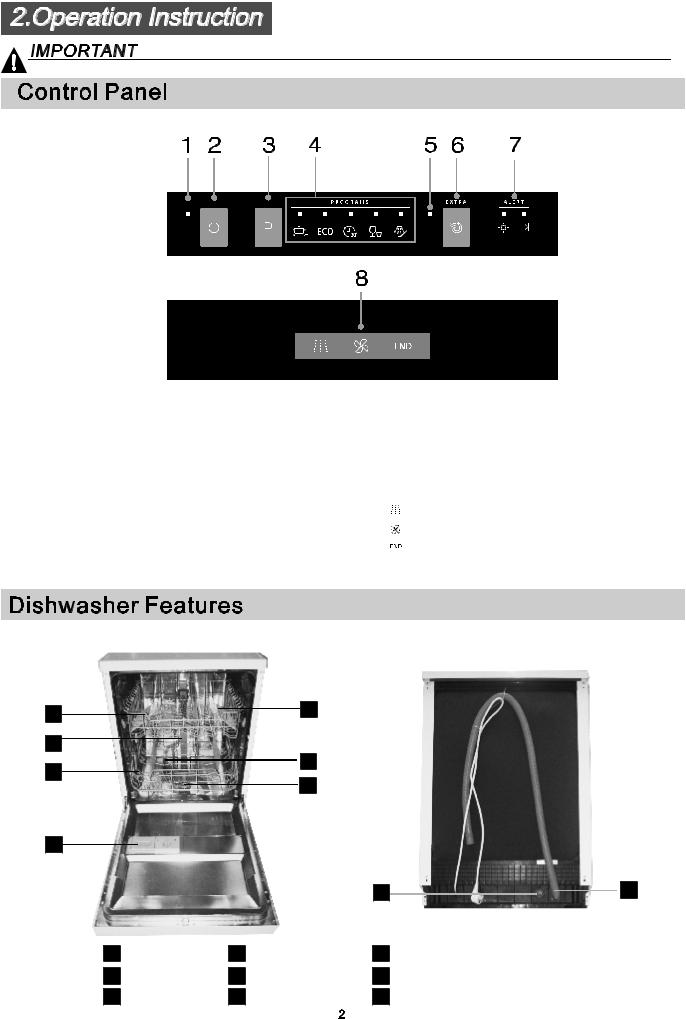
To get the best performance from your dishwasher, read all operating instructions before using it for the first time.
1.Power indicator: To show when the power is on. 2.On/Off Button: To turn on/off the power supply.
3.Program Button : To press the button to select a wash Program.
4.Program indicator: To show which program you have chosen.
5.Extra drying indicator
6.Extra drying button: Press the button to select the Extra dry function.
7.Cycle finish and rinse aid warning indicators: To show when the washing program is finished, the dispenser need to be refilled.
8.Display screen: to show running state
Washing state
Drying state Program is end
Front view Back View
1 |
5 |
|
2 |
6 |
|
3 |
|
|
7 |
|
|
|
|
|
4 |
|
|
|
8 |
9 |
1
2
3
Upper Basket Inner pipe Lower Basket
4
5
6
Dispenser
Cup Shelf
Spray arms
7
8
9
Filter assembly
Inlet pipe connector
Drain pipe
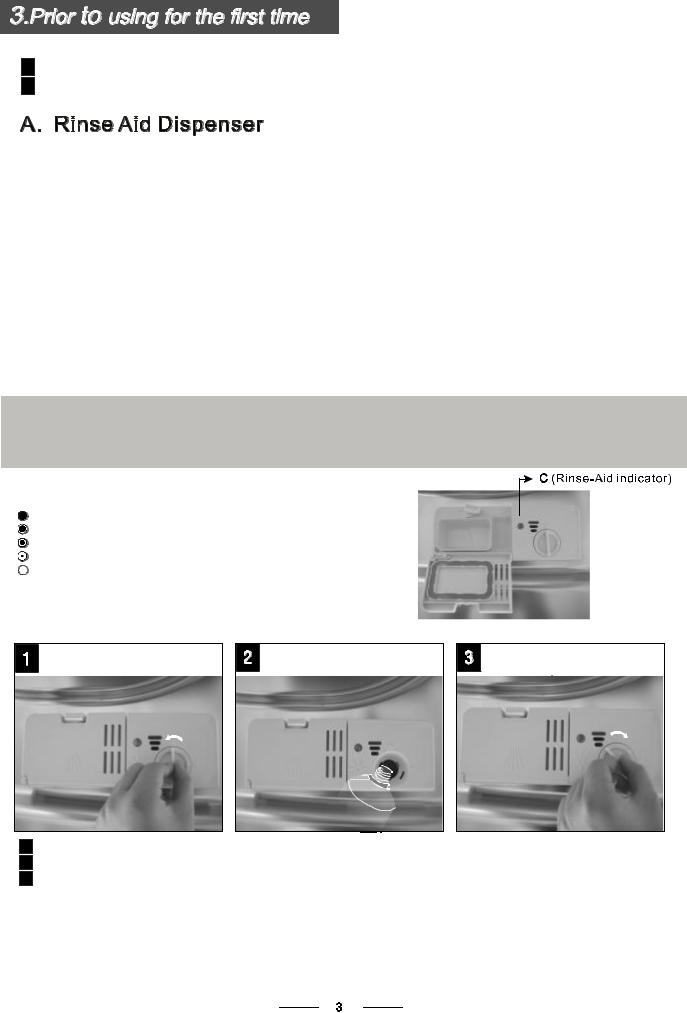
Before using your dishwasher for the first time:
A.Fill the rinse aid dispenser
B.Fill in detergent
Rinse Aid Dispenser
The rinse aid is released during the final rinse to prevent water from forming droplets on your dishes, which can leave spots and streaks. It also improves drying by allowing water to roll off the dishes. Your dishwasher is designed to use liquid rinse aids. The rinse aid dispenser is located inside the door next to the detergent dispenser. To fill the dispenser, open the cap and pour the rinse aid into the dispenser until the level indicator turns completely black. The volume of the rinse aid container is about 110ml.
Function of Rinse Aid
Rinse aid is automatically added during the last rinse, ensuring thorough rinsing, and spot and streak free drying.
Attention!
Only use branded rinse aid for dishwasher. Never fill the rinse aid dispenser with any other substances (e.g. Dishwasher cleaning agent, liquid detergent). This would damage the appliance.
When to Refill the Rinse Aid Dispenser
If there is no rinse-aid warning light in the control panel, you can judge the amount of rinse-aid by the color of the optical level, indicator "C" located next to the cap. When the rinse-aid container is full, the whole indicator will be dark .As the rinse-aid diminishes, the size of the dark dot decreases. You should never let the rinse aid get below 1 / 4 full.
As the rinse aid diminishes, the size of the black dot
on the rinse aid level indicator changes, as illustrated below.
Full
3 / 4 full
1 / 2 full
1 / 4 full - Should refill to eliminate spotting Empty
How to fill the Rinse Aid Dispenser
1 To open the dispenser, turn the cap to the "open" (left) arrow and lift it out.
2Pour the rinse aid into the dispenser, being careful not to overfill.
3Replace the cap by inserting it aligned with "open" arrow and turning it to the closed (right) arrow.
Be careful not to overfill the dispenser, because this could cause over sudsing. Wipe away any spills with a damp cloth. Don't forget to replace the cap before you close dishwasher door.
Attention!
Clean up any rinse aid spill during filling with an absorbent cloth to avoid excess foaming during the next wash.
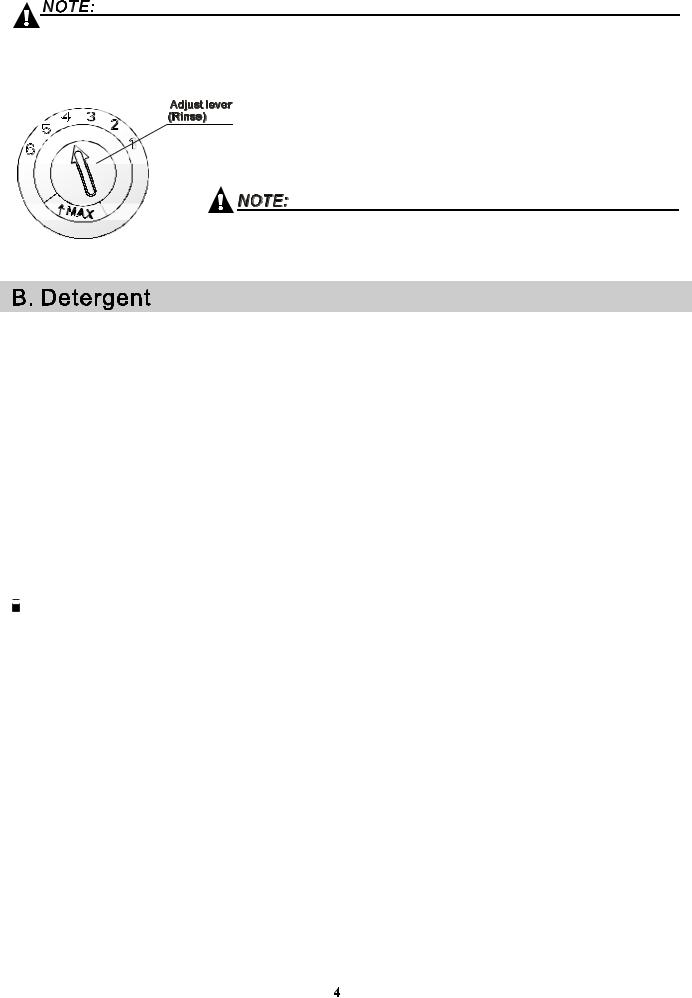
Clean up any rinse aid spilled while during filling with an absorbent cloth to avoid excessive foaming during the next wash. Don't forget to replace the cap before you close dishwasher door.
Adjusting Rinse Aid Dispenser
The rinse aid dispenser has six or four settings. Always start with the dispenser set on "4". If spots and poor drying are a problem, increase the amount of rinse aid dispensed by removing the dispenser lid and rotating the dial to "5". If the dishes still are not drying properly or are show spots, adjust the dial to the next higher lever until your dishes are spot-free. The recommended setting is "4". (Factory value is "4".)
Increase the dose if there are drops of water or lime spots on the dishes after washing. Reduce it if there are sticky whitish stains on your dishes or a bluish film on glassware or knife blades.
Detergents have chemical ingredients that are necessary to remove dirt, crush dirt and transport it out of the dishwasher. Most of the commercial quality detergents are suitable for this purpose.
Detergents
There are 3 sorts of detergents
1.With phosphate and with chlorine
2.With phosphate and without chlorine 3.Without phosphate and without chlorine
Normally new pulverised detergent is without phosphate. Thus the water softener function of phosphate is not given. If detergents without phosphate are used in the case of hard water
often white spots appear on dishes and glasses. In this case please add more detergent to reach better results. Detergents without chlorine do only bleach a little. Strong and coloured spots will not be removed completely. In this case please choose a program with a higher temperature.
Concentrated Detergent
Based on their chemical composition, detergents can be split in two basic types:  Conventional, alkaline detergents with caustic components
Conventional, alkaline detergents with caustic components
Low alkaline concentrated detergents with natural enzymes
The use of normal washing programs in combination with concentrated detergents
reduces pollution and is good for your dishes; these wash programs are specifically matched to the dirt-dissolving properties of the enzymes of the concentrated detergent. For this reason normal wash programs in which concentrated detergents are used can achieve the same results that can otherwise only be achieved using intensive programs.
Detergent Tablets
Detergent tablets of different brands dissolve at different speeds. For this reason some detergent tablets cannot dissolve and develop their full cleaning power during short programs. Therefore please use long programs when using detergent tablets, to ensure the complete removal of detergent residuals.
Detergent Dispenser
The dispenser must be refilled before the start of each wash cycle following the instructions provided in the wash cycle table . Your dishwasher uses less detergent and rinse aid than Conventional dishwasher. Generally, only one tablespoon of detergent is needed for
a normal wash load. More heavily soiled items need more detergent. Always add the detergent just before starting the dishwasher, otherwise it could get damp and will not dissolve properly.
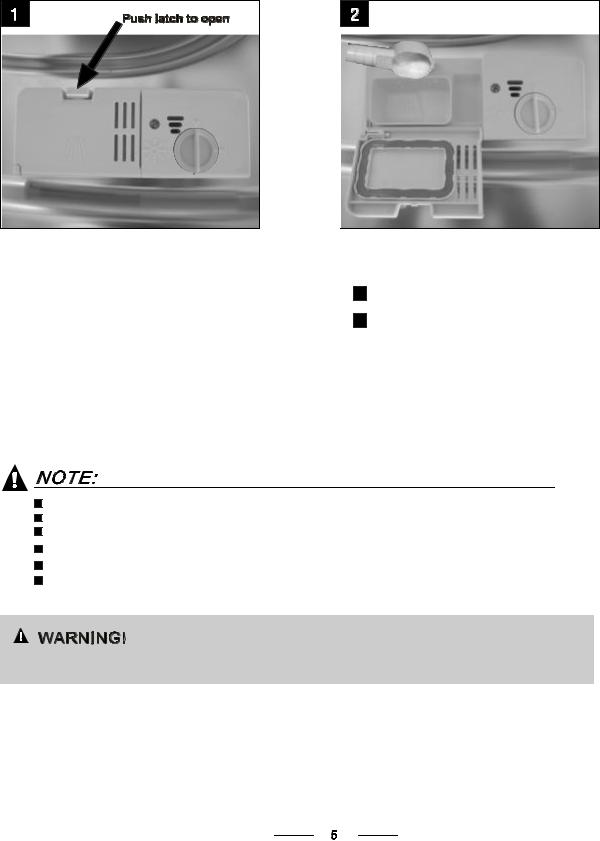
Proper Use of Detergent
Use only detergent specifically made for the use in dishwashers. Keep your detergent fresh and dry. Don't put powdered detergent into the dispenser until you're ready to wash dishes.
Adding detergent to dispenser
A B
Fill in Detergent
Fill the detergent dispenser with detergent. The marking indicates the dosing levels , as illustrated on the right:
Please observe the manufacturers dosing and storage Recommendations as stated on the detergent packaging.
Close the lid and press until it locks in place.
A
B
For main wash detergent.
For pre-wash detergent.
If the dishes are heavily soiled, place an additional
detergent dose in the pre-wash detergent chamber. This detergent will take effect during the pre-wash phase.
If the lid is closed: push the latch to open.
Always add the detergent just before starting each wash cycle. Only use branded detergent and rinse aid for dishwasher.
You see information about the amount of detergent for the single programme page 8. Please be aware that soiling levels and water hardness can effect wash results. Please observe the manufacturer's recommendations on the detergent packaging.
Dishwasher detergent is corrosive!
Take care to keep it out of reach of children.
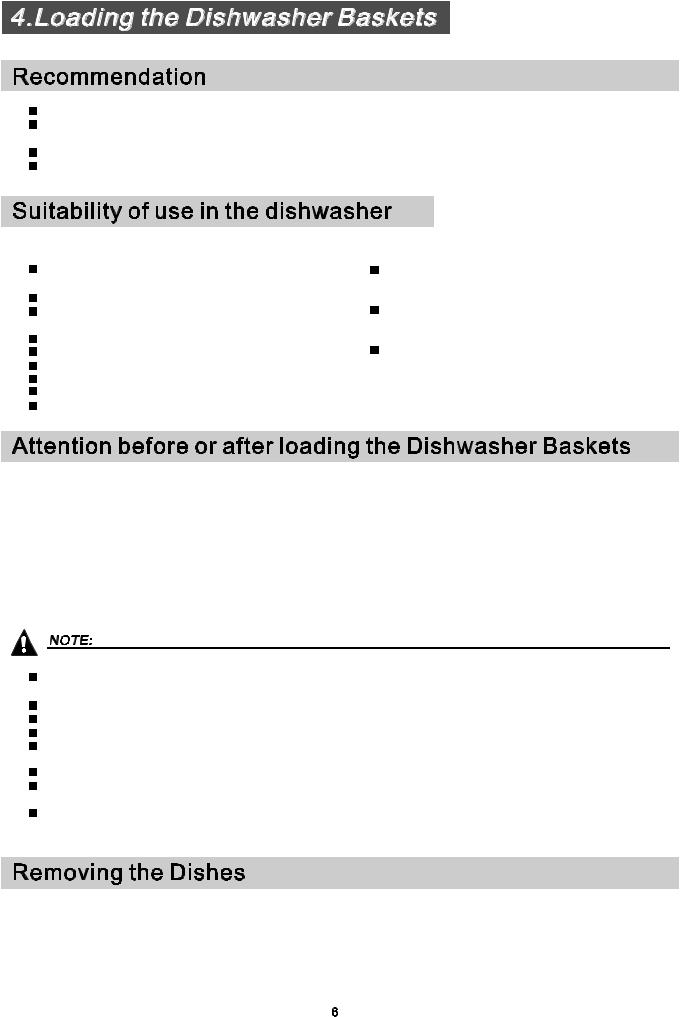
Consider buying utensils which are identified as dishwasher-proof.
Use a mild detergent that is described as 'kind to dishes'. If necessary, seek further information from the detergent manufacturers.
For particular items, select a program with as low temperature as possible.
To prevent damage, do not take glass and cutlery out of the dishwasher immediately after the program has ended.
Not suitable for use
Cutlery with wooden, horn china or mother-of-pearl handles.
Plastic items that are not heat resistant.
Older cutlery with glued parts that are not temperature resistant.
Bonded cutlery items or dishes.
Pewter or cooper items.
Crystal glass.
Steel items subject to rusting.
Wooden platters.
Items made from synthetic fibres.
Limited suitability
Some types of glasses can become dull after a large number of washes.
Silver and aluminum parts have a tendency to discolour during washing.
Glazed patterns may fade if machine washed frequently.
(For the best performance of the dishwasher, follow these loading guidelines. Features and appearance of baskets and cutlery baskets may vary from your model.)
Scrape off any large food particles. Soften remnants of burnt food in pans. It is not necessary to rinse the dishes under running water.
Place objects in the dishwasher in following way:
1.Items such as cups, glasses, pots/pans, etc. are faced downwards.
2.Curved items, or ones with recesses, should be loaded aslant so that water can run off. 3.All utensils are stacked securely and can not tip over.
4.All utensils are placed in the way that the spray arms can rotate freely during washing.
Very small items should not be washed in the dishwasher as they could easily fall out of the basket.
Load hollow items such as cups, glasses, pans etc. With the opening facing downwards so that water cannot collect in the container or a deep base.
Dishes and items of cutlery must not lie inside one another, or cover each other. To avoid damage to glasses, they must not be touched.
Load large items which are most difficult to clean into the lower basket.
The upper basket is designed to hold more delicate and lighter dishware such as glasses, coffee and tea cups.
Long bladed knives stored in an upright position are a potential hazard!
Long and/or sharp items of cutlery such as carving knives must be positioned horizontally in the upper basket.
Please do not overload your dishwasher. This is important for good results and for reasonable consumption of energy.
To prevent water dripping from the upper basket into the lower basket, we recommend that you empty the lower basket first and then the upper basket.
